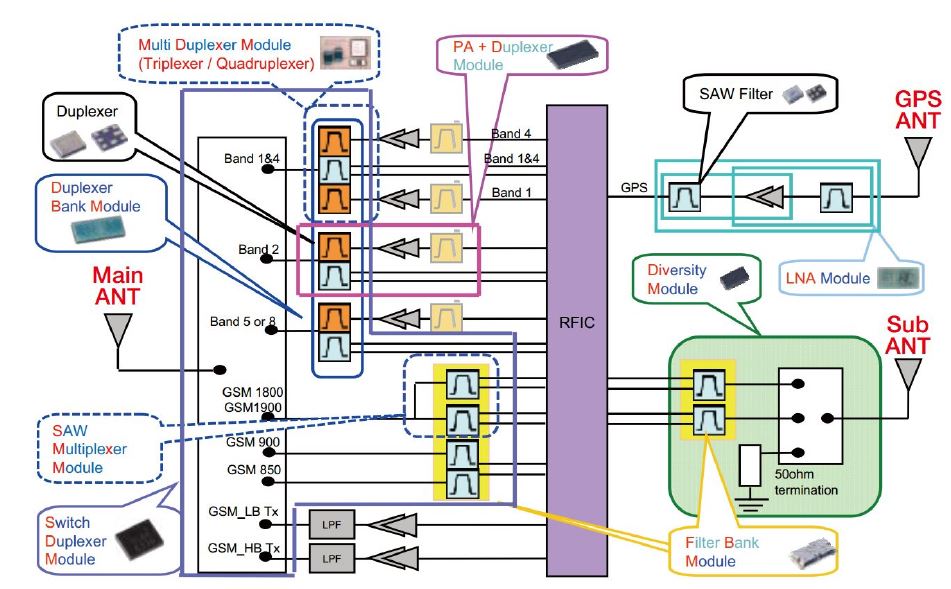|
What's in this issue:
|
Future of Filtering Circuit in CommunicationIn communication system, filter is a device or process which selects the frequency to pass the associated signal. This process is not so simple as it looks like. It involves complex circuitry to achieve an efficient performance and also has to suppress unwanted signals. We have many ways to design these filter circuits by using active and passive electronic components but these kind of filters are not sufficient sometimes. Therefore, we need advanced techniques to achieve these operations in radio frequency (RF) receiver architecture. Surface acoustic wave (SAW) device is one such kind of device which provides the best result when used as a filter. Even though it is bulky in nature but still it is used in many filtering application including RF receiver. 
SAW was first discovered in 1885 but after the invention of IDT (inter digital transducer) it is being used for many applications. IDT was the reason that SAW filter started to become attractive. Generally, two kinds of basic SAW filters are used i.e. DMS (double mode SAW) and Ladder type. In wireless system, there is a tradeoff between noise, frequency of operation, tolerance of interference, power dissipation and cost of the device. Therefore, in modern world, we are designing the whole circuit on an integrated circuit (IC) which uses silicon (Si) substrate to maintain a balance between above-mentioned parameters. In similar development, researchers are also trying to develop SAW device on Si substrate. Fabrication of IDTs using standard CMOS process is the key to achieve this. There is also one more challenge with RF SAW device to generate high frequency on CMOS substrate. Solution to this problem is to use smart materials or try another method of design such as using MEMS technology and electron beam lithography (advance fabrication technique). There is a need to increase the band in Gigahertz frequency range. Therefore, demand of filters in GHz band which also need wider bandwidth at the same time. Ladder type filters are one which satisfied this need. Researchers are also trying BAW (bulk acoustic wave) filter for higher frequency operation. SAW filters are easy to develop up to 1 GHz without using any special technique and above this frequency range SAW and BAW filters are competing for their share. With the rise of cellular phone and introduction of heterodyne receiver concept, SAW IF filters were used for more than 10 years up to year 2000. SAW filters have become an integral part of receiver architecture, therefore, it is used in cellular phones till date in spite of its bigger size as compared to receiver IC. 
As mentioned earlier that the number of frequency bands supported by smartphone is increasing. Therefore, it is required to have additional filters. For example, if one band is released in one geographic location then manufacturers start adding this band in their products. For each band on an average three RF filters are required. In an estimation, it is found that each FDD (frequency division duplex) uses two RF filters (one duplexer and one receiver filter) and each TDD (time division duplex) uses three RF filters (one transmitter filter, one primary receiver filter and one receiver filter). 3GPP is governing the global standards for cellular telecom network technology. First 3GPP LTE (long term evolution-4G standard) standard’s release8 constitutes 15 FDD bands and 8 TDD bands with a frequency range from 700MHz to 2.6 GHz and release14 constitutes 30 FDD and 20 TDD with 450 MHz to 5.9 GHz. With reference to this discussion, you can get an idea regarding the required filters in modern day cell phone. Typically, more than 60 filters are used in one cell phone. Few techniques such as carrier aggregation (CA) and MIMO (multiple input, multiple output) has further increased the number of filters used which will be used in 5G technology cell phone.
|
Want to visit RSF-EEE Homepage, Click here!

|
Created By RSF-EEE Team 2017 E-mail us at: rsfeee@iitg.ernet.in |
Connect with RSF-EEE: |
Copyright © RSF-EEE Team 2017-18. All rights reserved.
Thank you for visiting the page.
Thank you for visiting the page.

